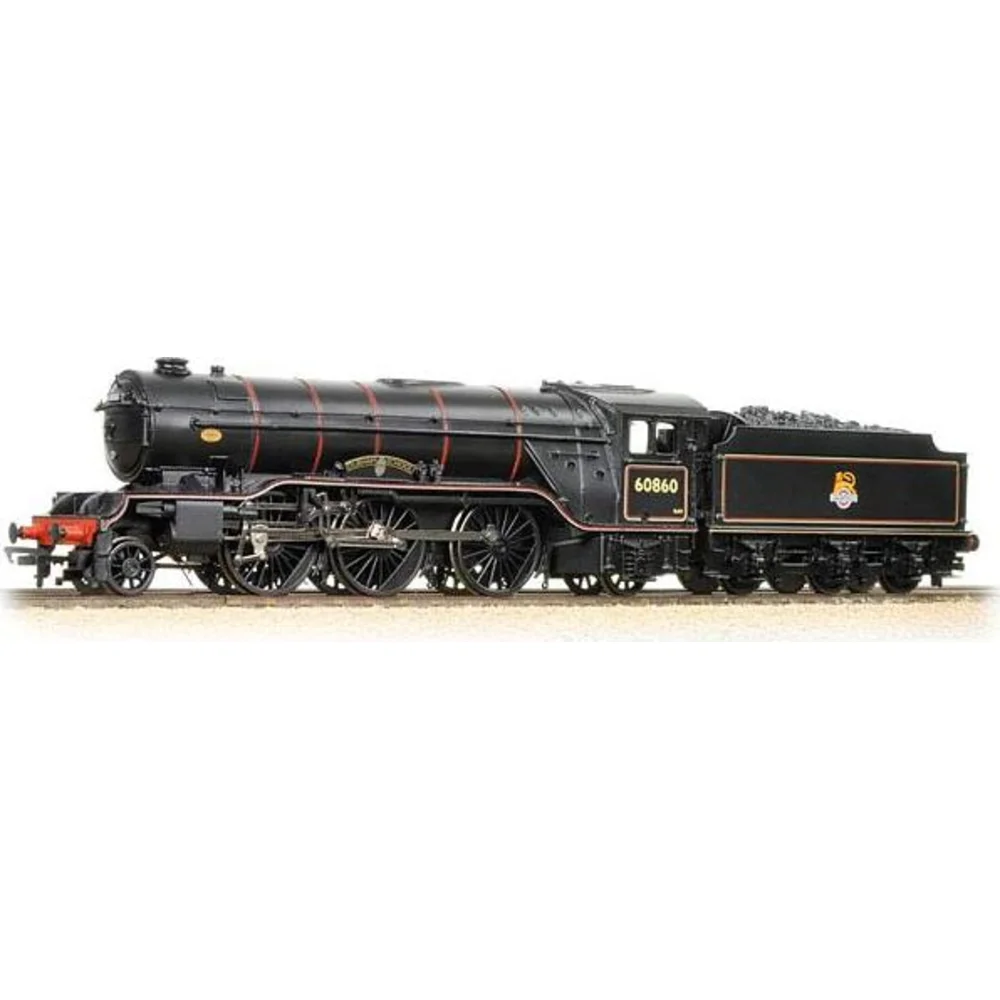Bachmann 31-564
London & North Eastern Railway V2 60860 Durham School British Railways Lined Black with Early Emblem
Tooling
In 2012, Bachmann Branchline introduced a major upgrade to its OO gauge model of the LNER Class V2, replacing the original 1992 split-chassis tooling. This retooling aimed to deliver improved accuracy, reliability, and modern features such as DCC readiness, addressing long-standing criticisms of the earlier design. The V2, designed by Sir Nigel Gresley, was a mixed-traffic locomotive built between 1936 and 1944, and remains an iconic subject for British railway modellers.
Tooling Features
- Scale: OO gauge (1:76).
- Construction: Precision-moulded plastic bodyshell with a die-cast chassis for strength and weight.
- Detailing: Improved body proportions, separately fitted handrails, finer valve gear, detailed cab interior with glazing, and accurate tender variations.
- Couplings: NEM pockets with tension-lock couplers, replacing the fixed couplers of the earlier tooling.
Mechanical & Electrical
- Motor & Drive: Smooth-running can motor mounted in the chassis, driving the coupled wheels via a reliable gear train.
- Minimum Radius: Recommended for second radius curves (approx. 438 mm).
- Lighting: No factory lighting provided.
- Weighting: Die-cast chassis and internal metal components for improved traction.
DCC Capability
- DCC Ready with an 8-pin socket located in the tender.
- Space provided for a speaker to allow sound installation by the modeller.
Liveries Produced
The 2012 tooling was released in several authentic schemes, including:
- LNER Lined Green (Doncaster style)
- LNER Black
- BR Lined Black (early emblem)
- BR Green (late crest)
- Special editions such as preserved No. 4771 “Green Arrow”
Reviews & Commentary
At launch, the 2012 V2 was welcomed for its improved mechanism and DCC readiness compared to the split-chassis predecessor. However, some enthusiasts noted shortcomings in body shape accuracy, particularly around the firebox and smokebox, and commented on the relatively light weight affecting haulage. Online discussions and blogs highlighted that additional ballast could improve performance. Despite these criticisms, the model was considered a significant step forward and remained popular until the full retooling in 2021.
Interesting Notes
- The 2012 upgrade introduced a fixed Cartazzi rear axle design, improving stability over curves.
- Enthusiasts often added lead weight to enhance traction, a common modification discussed in forums.
Class & Prototype
- Class: London & North Eastern Railway V2
- Traction: Steam
- Built: 1936-1944
- Total Built: 184
- Running Number: 60860
- Name: Durham School
Operator & Livery
- Operator: British Railways
- Livery: Lined Black with Early Emblem
- Era: 4 - British Railways Early Emblem
British Railways transformed Britain's fragmented rail network into a unified national system following nationalisation on 1st January 1948. Created from the "Big Four" companies under the Transport Act 1947, BR operated most of Great Britain's railways until rebranding as British Rail in 1965, managing over 20,000 route miles and inheriting nearly 20,000 locomotives of diverse designs.
The organisation pioneered standardisation through its revolutionary BR Standard locomotive programme (1951-1960), producing 999 advanced steam engines under Robert Riddles' direction. These included the versatile Britannia Pacifics, mighty 9F freight engines, and mixed-traffic classes that incorporated the best features from all predecessor companies. The 1955 Modernisation Plan accelerated diesel and electric traction development, creating fascinating mixed-traction operations.
Notable achievements included establishing unified locomotive classification systems, introducing distinctive corporate liveries, and managing the complex transition from steam to modern traction. BR's six regional structure preserved operational diversity whilst enabling standardisation of practices, signalling, and rolling stock that had eluded private enterprise for over a century.
The BR era represents steam traction's final flowering alongside emerging diesel technology, creating unparalleled locomotive variety. Today, this heritage remains highly popular with railway enthusiasts through extensive preserved fleets, heritage railway operations, and comprehensive model ranges from manufacturers like Hornby, Bachmann, and Dapol, making BR subjects essential for authentic post-war British railway modelling across all scales.
British Railways' lined black livery was designated for mixed-traffic and secondary passenger locomotives from 1949, following pure LNWR style with black base colour and elaborate red, cream (off-white), and grey lining patterns. The lining specification comprised 5/8" grey, 1/8" cream, 1½" black, and ¼" red bands, with the layout consistent with LNWR practice including deep and shallow valances lined along bottom edges only, unlike green engines. The first lined black engines appeared in August 1948 when Hall 5954 appeared so painted, becoming one of the first to carry the "Lion and Wheel" emblem around the same time.
A wide range of engines was eligible for this livery, from powerful V2s and Counties down to tiny Southern Terriers, encompassing County, Hall, Grange, Manor, Saint, Prairie tanks, and numerous pre-grouping designs of varied shapes and sizes. This created many variations and interpretation problems due to the diverse locomotive types involved, with regional differences in splasher lining treatment—the Eastern Region used red-only splasher lining, whilst the Southern Region evolved from inset to edge lining styles. The emblem was positioned centrally on tender sides above the middle axle box, with the Western Region favouring larger sizes on tenders and bigger tank engines. An interesting period detail saw number plates routinely painted red from late 1949 to early 1952, adding colour contrast to the otherwise black scheme. This livery represented BR's commitment to standardising mixed-traffic operations whilst maintaining the decorative traditions that distinguished passenger-rated locomotives from plain freight engines.
